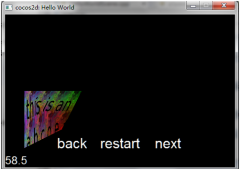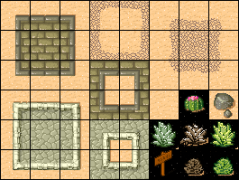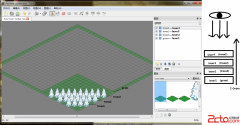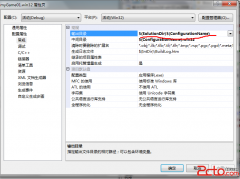cocos2d-x学习笔记-CCSprite(精灵)
精灵是游戏中十分重要的组成部分,随处可见,如:游戏背景、NPC、人物、道具等。在cocos2d-x引擎中,只要是用图片展示的,基本上需要使用精灵类。
1. 首先来了解一下跟精灵相关的几个类:
(1) CCTexture2D
可以把它看成一个纹理,它是cocos2d-x渲染图形的重要参数,用来贴图,因为cocos2d-x使用opengl es绘制2d图形的,它的尺寸是2的n次方。一般通过以下方式获得:
[cpp]
CCTexture2D* cache = CCTextureCache::sharedTextureCache()->addImage("hero.png");
(2) CCSprite
这个就是精灵类,是CCNode的子类,它的内部封装了CCTexture2D(纹理),可以通过下面几种方式初始化精灵对象。
[cpp]
//CCTexture2D表示精灵包含的图片,范围是整张图片
static CCSprite* spriteWithTexture(CCTexture2D *pTexture);
//CCRect表示图片的指定范围,即从图片的指定矩形区域裁剪
static CCSprite* spriteWithTexture(CCTexture2D *pTexture, const CCRect& rect);
//CCSpriteFrame表示精灵的某一帧,大多数情况下精灵本身的图片有多帧。它内部封装了CCTexture2D和CCRect,可以从一个大图片取出一部分作为一帧。
static CCSprite* spriteWithSpriteFrame(CCSpriteFrame *pSpriteFrame);
//pszSpriteFrameName表示帧的名字,根据帧名从内存中取出CCSpriteFrame
static CCSprite* spriteWithSpriteFrameName(const char *pszSpriteFrameName);
//pszFileName表示本地图片文件名
static CCSprite* spriteWithFile(const char *pszFileName);
static CCSprite* spriteWithFile(const char *pszFileName, const CCRect& rect);
static CCSprite* spriteWithBatchNode(CCSpriteBatchNode *batchNode, const CCRect& rect);
下面是两种比较常用的初始化精灵的方式:
[cpp]
CCSprite* sprite = CCSprite::spriteWithFile("hero.png");
/** 或者 **/
CCTexture2D* cache = CCTextureCache::sharedTextureCache()->addImage("hero.png");
CCSprite* sprite = CCSprite::spriteWithTexture(cache);
(3) CCTextureCache
它相当于CCTexture2D的容器,是内存池,用来缓存CCTexture2D对象的,它内部有一个字典CCMutableDictionary m_pTextures,key为图片的名称,值是CCTexture2D。当调用它的addImage函数添加图片时,会先根据图片名称去内存中查找是否已存在,是则直接取出返回。下面是addImage部分源码:
[cpp]
CCTexture2D * CCTextureCache::addImage(const char * path)
{
CCTexture2D * texture = NULL;
std::string pathKey = path;
CCFileUtils::ccRemoveHDSuffixFromFile(pathKey);
pathKey = CCFileUtils::fullPathFromRelativePath(pathKey.c_str());
texture = m_pTextures->objectForKey(pathKey);
std::string fullpath = pathKey; // (CCFileUtils::fullPathFromRelativePath(path));
if( ! texture )
{
/** .... */
}
return texture;
}
如果需要一次加载多张图片的时候,可以先把图片加载到CCTextureCache中,这样使用图片的时候速度就会很快了。
(4) CCSpriteBatchNode
它是批处理绘制精灵,主要是用来提高精灵的绘制效率的,需要绘制的精灵数量越多,效果越明显。因为cocos2d-x采用opengl es绘制图片的,opengl es绘制每个精灵都会执行:open-draw-close流程。而CCSpriteBatchNode是把多个精灵放到一个纹理上,绘制的时候直接统一绘制该texture,不需要单独绘制子节点,这样opengl es绘制的时候变成了:open-draw()-draw()…-draw()-close(),节省了多次open-close的时间。CCSpriteBatchNode内部封装了一个CCTextureAtlas(纹理图集,它内部封装了一个CCTexture2D)和一个CCArray(用来存储CCSpriteBatchNode的子节点:单个精灵)。注意:因为绘制的时候只open-close一次,所以CCSpriteBatchNode对象的所有子节点都必须和它是用同一个texture(同一张图片),类似下面这样的图片,4个贝壳都在同一纹理上:
在addChild的时候会检查子节点纹理的名称跟CCSpriteBatchNode的是不是一样,如果不一样就会出错,源码:
[cpp] Child(CCNode *child, int zOrder, int tag)
{
/** ... */
// check CCSprite is using the same texture id
CCAssert(pSprite->getTexture()->getName() == m_pobTextureAtlas->getTexture()->getName(), "");
/** ... */
}
下面是使用CCSpriteBatchNode的使用代码示例:
[cpp]
CCSpriteBatchNode* BatchNode1 = CCSpriteBatchNode::batchNodeWithFile("Images/grossini_dance_atlas.png", 50);
addChild(BatchNode1, 0, kTagSpriteBatchNode);
CCSpriteBatchNode* BatchNode = (CCSpriteBatchNode*) getChildByTag( kTagSpriteBatchNode );
int idx = CCRANDOM_0_1() * 1400 / 100;
int x = (idx%5) * 85;
int y = (idx/5) * 121;
CCSprite* sprite = CCSprite::spriteWithTexture(BatchNode->getTexture(), CCRectMake(x,y,85,121));
BatchNode->addChild(sprite);
sprite->setPosition( ccp( p.x, p.y) );
(5) CCSpriteFrameCache
它是管理CCSpriteFrame的内存池,跟CCTextureCache功能一样,不过跟CCTextureCache不同的是,如果内存池中不存在要查找的帧,它会提示找不到,而不会去本地加载图片。它的内部封装了一个字典:CCDictionary *m_pSpriteFrames,key为帧的名称。CCSpriteFrameCache一般用来处理plist文件(这个文件指定了每个独立的精灵在这张“大图”里面的位置和大小),该文件对应一张包含多个精灵的大图,plist文件可以使用TexturePacker制作。如下图所示:
下面是使用CCSpriteFrameCache的使用代码示例:
[cpp]
CCSpriteFrameCache* cache = CCSpriteFrameCache::sharedSpriteFrameCache();
cache->addSpriteFramesWithFile("animations/grossini.plist", "animations/grossini.png");
m_pSprite1 = CCSprite::spriteWithSpriteFrameName("grossini_dance_01.png");
m_pSprite1->setPosition( ccp( s.width/2-80, s.height/2) );
只要plist文件跟对应的png图片在同一目录下,且名字相同,则addSpriteFramesWithFile(“animations/grossini.plist”, “animations/grossini.png”)可以改成addSpriteFramesWithFile(“animations/grossini.plist”);
2. CCSpriteBatchNode和CCSpriteFrameCache结合使用
必须保证CCSpriteFrameCache和CCSpriteBatchNode加载的是同一纹理贴图。
[cpp]
CCSpriteFrameCache::sharedSpriteFrameCache()->addSpriteFramesWithFile("animations/ghosts.plist", "animations/ghosts.png");
CCSpriteBatchNode *aParent = CCSpriteBatchNode::batchNodeWithFile("animations/ghosts.png");
addChild(aParent, 0, kTagSprite1);
CCSprite *pFather = CCSprite::spriteWithSpriteFrameName("father.gif");
pFather->setPosition(ccp( s.width/2, s.height/2));
aParent->addChild(pFather, 0, kTagSprite2);
相关新闻>>
- 发表评论
-
- 最新评论 进入详细评论页>>

![cocos2d_x+lua[2]](/uploads/allimg/131030/110J64609-0-lp.jpg)








